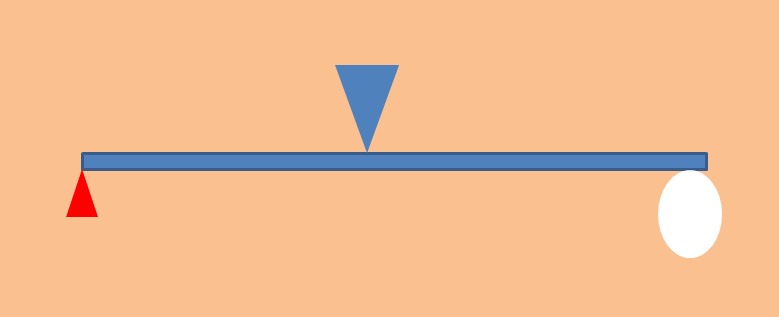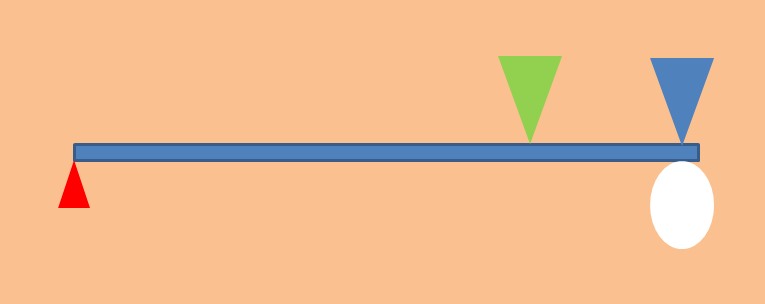I visited Mrs. McDavid's eighth grade science class to help them investigate some aspects of force and motion.
We looked at how levers can be used to multiply forces then we used that so we could see just how much weight an egg would support.
Here is the setup.
The blue bar is the board we used as the lever.
The red triangle represents a hinge that forms the fulcrum.
Of course the white oval represents the egg.
The blue triangle represents the weight of the first student that is providing the load on the egg.
The student starts at the fulcrum and slowly moves toward the egg end.
As they do progressively more of their weight is transfered from the fulcrum to the egg.
For example, if they are 50% of the way along the lever then 50% of their weight is on the egg.

Here the first student (blue triangle) has moved until 100% of their weight is on the egg and a second student (green triangle) has about 77% of their weight on the egg.

Some details of the actual mechanism differ from the simple diagram but the effect is the same.
We use two eggs that divide the force between them with a short lever.
They sit in and are capped by clay in cup shaped indentations to spread the weight equally on them.
These pictures show that detail.
The first student gets on and moves toward the eggs.
The helper is there to steady her to minimize wiggles that would unevenly load the eggs and cause them to break prematurely.
The second student begins to add her weight to the lever.
The actual positions of the first two students were 90% and 70% of the length of the lever.
A third student adds his weight.
And as he moves up the lever the eggs fail.
The actual weight supported by the eggs was 329.8 pounds or 164.9 pounds on each egg.
We were lucky to get a picture just as the eggs failed.
Each of the classes repeated the experiment.
Here is another starting their test.
And a video of the process in another class.
We repeated the test in each of the classes.
The average weight supported by one egg was 125.3 pounds and the most weight one egg supported was 164.9 pounds
We investigated pulley systems by having a student try to lift me using a single pulley (no luck).
Then another one used a block and tackle with a mechanical advantage of 6 (no problem).
Some of the students and Mrs. McDavid had a chance to see the effect of angular momentum.
When something rotates it has angular momentum due to it's speed and the distribution of mass with respect to the axis of rotation.
In this case they sat on a swivel chair with two gallon jugs about half full of water and then were spun around with their arms outstretched.
When they brought the jugs close to the axis of rotation conservation of angular momentum made them rotate more quickly.
Some of them surprisingly so.
Very few of the students had ever played with a gyroscope so they were amazed with how it felt when they tried to turn it over.
A common comment was "It feels like it's ... alive."
Then we tried a much larger gyroscope.
They were sitting on the swivel chair again so when the wheel was spinning and they tried to tip it to the side they started to rotate on the chair (precess).
They all found it hard to believe.
After school the science club had the chance to see some of the effects of cryogenic temperatures.
Here is a demonstration of superconductivity.
The black disk is superconductive when it is cooled with liquid nitrogen.
The little cube is a rare earth magnet.
As it is moved toward the disk there is an electrical current induced in the disk.
That creates a magnetic field that exactly opposes the one from the magnet.
The two fields repel each other and support the magnet.
Of course we made liquid nitrogen ice cream.
After enjoying the ice cream we went outside to see the effect of pressure produced when liquid nitrogen turns to a gas.
Click here for more liquid nitrogen experiments.
